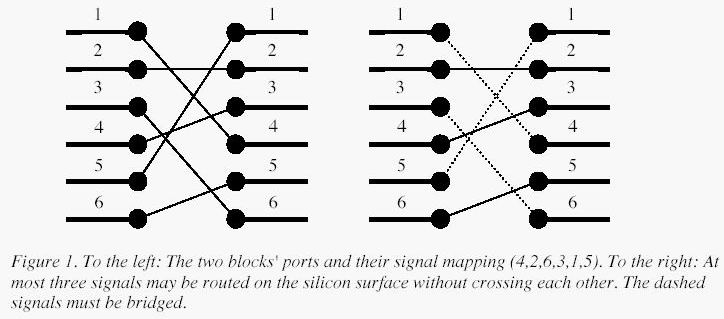POJ 1631 Bridging signals(LIS 二分法 高速方法)
|
Language:
Default
Bridging signals
Description
'Oh no, they've done it again', cries the chief designer at the Waferland chip factory. Once more the routing designers have screwed up completely, making the signals on the chip connecting the ports of two functional blocks cross each other all over the place.
At this late stage of the process, it is too expensive to redo the routing. Instead, the engineers have to bridge the signals, using the third dimension, so that no two signals cross. However, bridging is a complicated operation, and thus it is desirable to bridge as few signals as possible. The call for a computer program that finds the maximum number of signals which may be connected on the silicon surface without crossing each other, is imminent. Bearing in mind that there may be thousands of signal ports at the boundary of a functional block, the problem asks quite a lot of the programmer. Are you up to the task?
Input
On the first line of the input, there is a single positive integer n, telling the number of test scenarios to follow. Each test scenario begins with a line containing a single positive integer p < 40000, the number of ports on the two functional blocks. Then
follow p lines, describing the signal mapping:On the i:th line is the port number of the block on the right side which should be connected to the i:th port of the block on the left side. Output
For each test scenario, output one line containing the maximum number of signals which may be routed on the silicon surface without crossing each other.
Sample Input 4 Sample Output 3 Source |
因为数据太大。必需要用高速方法。我今天看这个看了好久。记住一点,c[i]代表长度为 i 的字串中,最后位最小的值
seach就是找寻以a[i]结尾的序列会有多长,然后就更新
代码:
#include<iostream>
#include<cstdio>
#include<cstring>
#include<algorithm>
#include<cmath>
#include<queue>
#include<stack>
#include<vector> #define L(x) (x<<1)
#define R(x) (x<<1|1)
#define MID(x,y) ((x+y)>>1) #define eps 1e-8
using namespace std;
#define N 100005 int a[N],c[N],n; int seach(int len,int x)
{
int le=0,ri=len,ans=0,mid;
while(le<=ri)
{
mid=(le+ri)>>1;
if(c[mid]<x)
{
ans=mid;
le=mid+1;
}
else
ri=mid-1;
}
return ans;
}
int main()
{
int i,j,t;
scanf("%d",&t);
while(t--)
{
scanf("%d",&n);
for(i=1;i<=n;i++)
scanf("%d",&a[i]); int len=1;
c[1]=a[1];
for(i=2;i<=n;i++)
{
if(a[i]>c[len])
{
j=len++;
}
else
j=seach(len,a[i]);
c[j+1]=a[i];
}
printf("%d\n",len);
}
return 0; }
版权声明:本文博主原创文章,博客,未经同意不得转载。
POJ 1631 Bridging signals(LIS 二分法 高速方法)的更多相关文章
- POJ 1631 Bridging signals (LIS:最长上升子序列)
题意:给你一个长为n(n<=40000)的整数序列, 要你求出该序列的最长上升子序列LIS. 思路:要求(nlogn)解法 令g[i]==x表示当前遍历到的长度为i的所有最长上升子序列中的最小序 ...
- POJ 1631 Bridging signals(LIS O(nlogn)算法)
Bridging signals Description 'Oh no, they've done it again', cries the chief designer at the Waferla ...
- OpenJudge/Poj 1631 Bridging signals
1.链接地址: http://poj.org/problem?id=1631 http://bailian.openjudge.cn/practice/1631 2.题目: Bridging sign ...
- POJ 1631 Bridging signals
Bridging signals Time Limit: 1000MS Memory Limit: 10000K Total Submissions: 9441 Accepted: 5166 ...
- poj 1631 Bridging signals (二分||DP||最长递增子序列)
Bridging signals Time Limit: 1000MS Memory Limit: 10000K Total Submissions: 9234 Accepted: 5037 ...
- Poj 1631 Bridging signals(二分+DP 解 LIS)
题意:题目很难懂,题意很简单,求最长递增子序列LIS. 分析:本题的最大数据40000,多个case.用基础的O(N^2)动态规划求解是超时,采用O(n*log2n)的二分查找加速的改进型DP后AC了 ...
- POJ 1631 Bridging signals(LIS的等价表述)
把左边固定,看右边,要求线不相交,编号满足单调性,其实是LIS的等价表述. (如果编号是乱的也可以把它有序化就像Uva 10635 Prince and Princess那样 O(nlogn) #in ...
- POJ - 1631 Bridging signals(最长上升子序列---LIS)
题意:左右各n个端口,已知n组线路,要求切除最少的线路,使剩下的线路各不相交,按照左端口递增的顺序输入. 分析: 1.设左端口为l,右端口为r,因为左端口递增输入,l[i] < l[j](i & ...
- POJ 1631 Bridging signals & 2533 Longest Ordered Subsequence
两个都是最长上升子序列,所以就放一起了 1631 因为长度为40000,所以要用O(nlogn)的算法,其实就是另用一个数组c来存储当前最长子序列每一位的最小值,然后二分查找当前值在其中的位置:如果当 ...
随机推荐
- JS 在 HTML 中做加减乘除
<script type="text/javascript"> function fun(t){ var fa = parseInt(document.getEleme ...
- KMP算法---字符串匹配
算法细节详见点击打开链接和点击打开链接 #include <stdio.h> #include <stdlib.h> #define N 7 #define M 15 void ...
- Java EE (6) -- Java EE 5 Enterprise Architect Certified Master
Section 1: Application Design Concepts and Principles Explain the main advantages of an object-orien ...
- 最简单的ADABOOST人脸检测程序。COPY执行,前提是你配置OpenCV周围环境
#include "cv.h" #include "highgui.h" #include "stdio.h" void main() { ...
- PKI系统深入的介绍
公钥基础设施(Public Key Infrastructure,缩写PKI)的基础与核心.是电子商务安全实施的基本保障.因此.对PKI技术的研究和开发成为眼下信息安全领域的热点. 本文对PKI技术进 ...
- json2.js参考
json2.js使用參考 json2.js提供了json的序列化和反序列化方法,能够将一个json对象转换成json字符串,也能够将一个json字符串转换成一个json对象. <html> ...
- ajax方式提交带文件上传的表单,上传后不跳转
ajax方式提交带文件上传的表单 一般的表单都是通过ajax方式提交,所以碰到带文件上传的表单就比较麻烦.基本原理就是在页面增加一个隐藏iframe,然后通过ajax提交除文件之外的表单数据,在表单数 ...
- Oracle使用并行建索引须要注意的问题
建索引时.我们为了建索引快.会加上并行,加上并行之后.此列索引就会是并行了. 訪问有并行度的索引时,CBO可能可能会考虑并行运行.这可能会引发一些问题,如在server资源紧张的时候用并行会引起更加严 ...
- HDU 1695 GCD 欧拉函数+容斥原理+质因数分解
链接:http://acm.hdu.edu.cn/showproblem.php?pid=1695 题意:在[a,b]中的x,在[c,d]中的y,求x与y的最大公约数为k的组合有多少.(a=1, a ...
- android-将系统和应用程序级的屏幕亮度
/** * 获取当前屏幕亮度模式 * SCREEN_BRIGHTNESS_MODE_AUTOMATIC=1 为自己主动调节屏幕亮度 * SCREEN_BRIGHTNESS_MODE_MANUAL=0 ...

